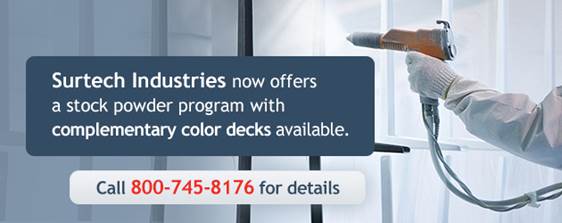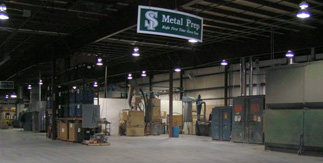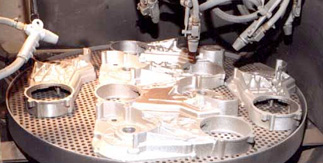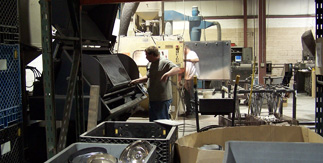
What Is the Metallizing Process?
"What is metallizing?"" That’s a question our customers often ask us here at Surtech Industries. Metallization is a general term that refers to the application of a metal coating to another metallic or non-metallic surface. Depending on the desired result, the coating can consist of metals such as zinc, gold, aluminum or silver.
The metallization process can protect the workpiece from damaging external forces (corrosion, wear, weathering, etc.), improve the appearance of the object (giving it a shiny look, for example), or enhance the finished product’s functionality. Industries that use metallization in their manufacturing processes include aerospace, automotive, oil & gas, defense, electrical and many others.
What Are the Benefits of the Metallizing Process?
Examples of the numerous benefits provided by the metallization process include:
- Enhanced corrosion protection — Rust is a common issue when working with most metals and especially with steel. Metallization can create a protective coating that inhibits the development of red and/or white rust, increasing the product’s lifespan by as much as 20 years or more.
- Increased durability — Most metallized coatings are known for their ability to adhere to the surface of the underlying workpiece or substrate. They are less likely to peel, blister, crack or flake than other types of finishes, which increases the substrate’s durability.
- Providing electrical conductivity — An issue when working with plastic materials is that they do not conduct electricity. Metallizing a plastic surface will enable it to transfer an electric current, which is a vital manufacturing step in the electronics industry.
- Greater weather resistance — The steel on outdoor structures is vulnerable to the impact of snow, rain, wind and sun over time. Metallization provides a protective coating that creates a barrier between the underlying structure and the elements, which can lengthen the structure’s lifespan and preserve its appearance.
- Reduced maintenance costs — Painted surfaces will need repainting periodically to preserve the finish. A metallized surface will not require repainting or upkeep, resulting in lower maintenance costs. Like paint, metallized coatings are available in a wide assortment of attractive colors to meet aesthetic requirements.
What Are the Various Metallization Processes?
In general, the metallization process entails preparing the surface via abrasive blasting to remove imperfections and defects, followed by the application of heat to produce molten particles that are sprayed onto the surface. Contact with the surface causes the particles to flatten out and freeze, which creates adhesion to the surface and between the individual particles.
Variations of the metallization process include:
- Vacuum metallizing — This form of metallization involves boiling the coating metal in a specially designed vacuum chamber and then allowing the condensation to form a deposit on the substrate’s surface. The coating metal can be vaporized via techniques such as plasma or resistance heating.
- Hot-dip galvanizing — HDG entails the immersion of a steel substrate into a vat of molten zinc. The zinc reacts with the iron in the steel to form an alloy coating the provides excellent corrosion protection. Upon removal of the substrate from the zinc bath, the substrate then undergoes a draining or vibrating process to remove the excess zinc. Galvanization will continue after substrate removal until it cools.
- Zinc spraying — Zinc is a versatile, cost-effective material that acts as a sacrificial barrier, which can prevent corrosion from reaching the surface of the substrate. Zinc spray produces a slightly porous coating that is less dense than hot-dip galvanizing. Zinc spray can be applied to any type of steel, although it may not consistently reach recessed areas or crevices.
- Thermal spraying — This process involves the spraying of heated or melted metals onto the substrate surface. The metal is fed in either powder or wire form, heated to a molten or semi-molten state and sprayed as micro-sized particles. Thermal spraying enables the application of thick coatings and a high metal deposition rate.
- Cold spraying — The cold spraying technique is typically used for applications that require long-lasting corrosion protection. The process entails the spraying of a composite consisting of a metal powder, water-based binder and a hardening agent. The mixture is sprayed onto the substrate at room temperature. The workpiece is allowed to “rest” for about an hour and then dried at a temperature between approximately 70° F and 150° F for 6-12 hours.
Contact Surtech Industries for All Your Metallization Needs
Surtech has offered exceptional metallization services since 1982. Our specialized metallizing processes work well for manufacturing applications that require durability and excellent corrosion protection. Contact us to learn more about the benefits of metallization and receive a free project quote today.



Contact Us!
- Address:
- 915 Borom Rd.
York, PA17404 - Phone:
- 717-767-6808
1-800-745-8176 - Online:
- Contact Us to request a free quote!
- Employee Directory:
- View our Employee Directory.
Definition:
Abrasive blast cleaning entails the forceful direction of abrasive particles against the surface of a product, to remove contaminants or to condition the surface for subsequent finishing. Present capabilities offer a wide range of manual and automated blasting processes to provide surface Ra finishes and cosmetic appearances up to a white metal designation (SSPC-SP10). Blast media include aluminum oxides, steel shot and grits, glass bead, and plastic media.